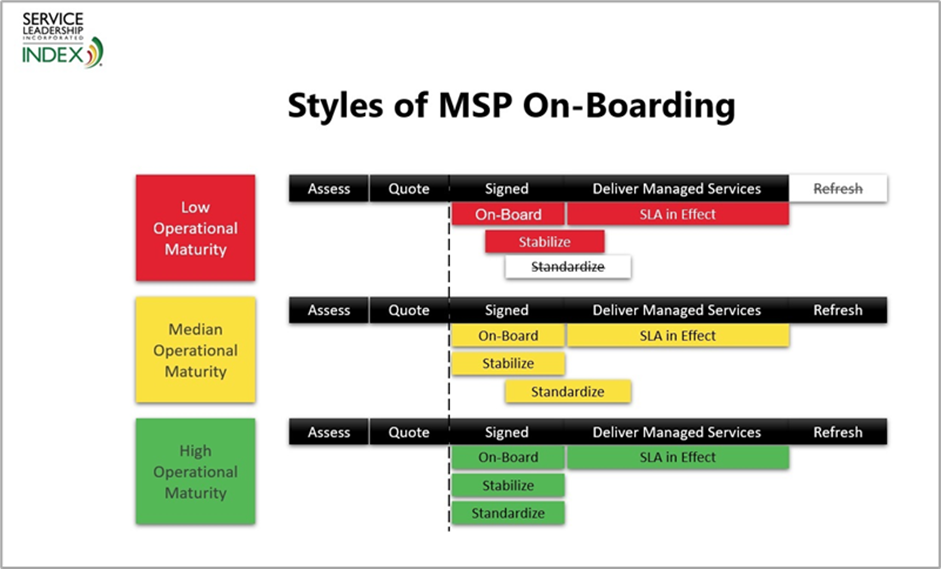If you want to achieve best-in-class (BIC) profitability, then you need to develop, adopt, and enforce the use of technology standards across virtually all (>95%) of your customers.
In this blog, we’ll explore why this is a key practice of top-performing managed service providers (MSPs), why enforcing compliance with these standards for all customers is crucial, and we’ll provide strategies for defining and maintaining your own standard technology stack.
Why standardizing your technology stack is essential
Driving the use of technology standards enables better service quality, scalability, and profitability. It also reduces overhead costs by increasing the effectiveness of the go-to-market plan. This is true for both services-centric firms and product-centric firms, where too-broad standards typically result in low service margins and quality, as well as slow responsiveness to sales, which in turn often results in low sales enthusiasm for selling services.
Ironically, narrowing technology standards improves service quality, margin and responsiveness to sales. These in turn accelerates services revenue growth and, strategic product revenue growth along with it. The key to growing product and services revenue faster is selling a narrower range of products.
Narrowing the range of technology you support
Dramatically narrowing the range of technology you’ll support under managed services is simple and has been proven for decades: It’s not possible to provide good support on a sustainable, predictable budget across a too-broad range of technology.
This is a basic management tenet of IT operations. MSPs that disregard it often find themselves faced with constant challenges of meeting committed service levels and continually higher service labor costs. Lack of standardization also plays havoc with many cost and quality functions—the budgets for technical headcount, technical training, tools, process development, and automation are all diluted across too many technologies. This results in either strongly escalating costs or increasingly poor service quality, or both.
For MSPs, they can and should dramatically narrow the range of technologies they support. It’s important that MSPs play an active role in controlling what their customers buy and use across their entire technology stack for many reasons, including:
Employing a technology standard also helps improve market differentiation by enabling a greater degree of specialization and expertise, which becomes evident to current and prospective customers through marketing and their own customer experience. Once the standards are enforced, improved service methodology drives higher service quality, and service revenue is further accelerated by better account retention and improved referral selling.
- Operational efficiency and profitability
Well-defined technology standards improve profitability by reducing the number of operational variables that must be taken into account when managing success. Thus, reducing complexity and investment across a wide variety of strategic to tactical factors.
Another benefit of narrowing the range of technologies is that over time you’ll realize dramatic improvements in operational and financial results, including:
- Greater staff flexibility: The more consistent your customers are, the easier it is for your technical team to move between them. Staff experience levels can be lower because you don’t need to cover as many different technical specialties, and you can spread off-hours work across a broader set of people because the basics about any given account are the same.
- Less staff training: If you only have one backup system or one type of firewall, you only need to train your team on those specific products—requiring less training and less documentation. Additionally, the onboarding training for new technical support team members will be shorter and they will be able to contribute faster.
- Lower inventory costs: Having the right parts on-hand for hot swaps is easier when there’s a limited number to stock.
- Easier software management: The more consistent your software environment is across customers, the easier it is to manage.
- Current hardware and software benefits: By evolving your set of standards and maintaining compliance with them, your customers never use outdated or obsolete hardware and software. Having a predetermined and universal set of standards can serve as a catalyst for upgrading customers to current norms.
Determining your technology standards
Every organization will have its own unique set of technology standards. You and your team can start first assessing the factors which will shape the technology standards for your organization by asking questions such as:
- What technology have you currently deployed in your customer base?
- Where does your existing staff have real expertise?
- What are your current practices for existing customers?
- What are your leading vendor relationships, and what assistance will they provide in helping you develop your technology standards?
In an ideal world, every customer has an identical environment. In reality, it’s never that simple. New customers and even existing customers that you wish to transition to a managed services model are likely to have a mix of hardware and software already in place.
Once you have created the list of standards, the next step is to determine which standards are non-negotiable and which ones have flexibility. An example of a non-negotiable requirement is antivirus software—every customer is required to run the same package. There might be more flexibility in a server or workstation configuration, but again, determine what is absolutely required and what is optional. Make sure this is documented and fully understood by both your sales and service teams so that they can set clear expectations for customers.
Get more advice on how to get started with standardization in our eBook, What I Wish I Knew When I Started Managed Services: Standardization.
Timing of completing a standardization project
Now that you have a good idea of what it takes to narrow your range of technologies, you’re probably wondering how long it will take to complete this whole standardization project. Let’s do a comparison of how low, medium, and high Operational Maturity Level (OML) MSPs approach this project.
In the chart below, we can see how MSPs at various OMLs usually handle standardization:

Figure 1: Comparing styles of on-boarding for MSPs at different OMLs
The high OML MSPs use the customer’s general desperation to have better IT as soon as possible as the lever by which they get them to standardize from the start. Not only does requiring customers to standardize right away lead to greater revenue growth for high OML MSPs, but it also allows:
- Their service team to provide great service without impossible super-heroics from the beginning
- Customers to get great service from the start, encouraging them to provide more and better referrals
- Higher customer retention and agreement to annual price increases
- Salespeople to be more motivated to sell and more confident in their sales motions
On the other hand, the low OML MSPs will tout their less-wise policies as competitive advantages. They may say something like: “We don’t make you standardize right away like those mean guys at [insert your company name here]. Unlike them, we have smart engineers who can handle your network as is (for now).”
This is the same tactic they will use with regard to your higher prices and your longer required contract term: “We know you’ll love us so much we’re willing to let you sign a month-to-month deal.”
There is no magic to managed services. These less-capable MSPs are not magically providing great service, making good money and building a happy, scalable business with these win/lose policies.
They are instead experiencing poor scalability, lower customer and employee retention, poor profits and poor growth.
The key to successfully implementing and enforcing your technology standards
Once you have defined your technology standards, you’ll need to require and enforce these standards both internally and with your customers. Getting all your MSP customers onto your standard technology stack is critical to your revenue growth, service quality (customer and employee happiness), and profitability. For top performers, standardization is what they use to require compliance by all of their customers. Unfortunately, many low-performing MSPs know they should do this but struggle to convince customers to rip-and-replace equipment and software that doesn’t meet their standards.
By now, most customers are consciously or semi-consciously aware that IT manufacturers—especially software vendors—continually advance their products from version 1 to version 2 to version 3, which is often accompanied by an upgrade fee. Some vendors may not call it a “version,” but minor and major updates are a fact of life.
A customer who is objecting to rip-and-replace is often consciously or semi-consciously expressing that they’re at a vendor version level that is either current or at least satisfactory to them. Their error when it comes to maintaining a win/win relationship with you is that they often believe that current—or close to current or not very close at all—is good enough for them and, therefore, good enough for you. They think the vendor is the arbiter of that decision.
The vendor is emphatically not the arbiter of that decision—you are. In saying yes to a managed services agreement, the customer is transitioning financial risk to you. It makes no more sense for them to expect you to accept their choice of equipment and software than it does for them to walk into a BMW dealer and ask to buy a new 5-Series but say:
“I would like your standard (all-inclusive four year) BMW Ultimate Service, but I would like you to remove your standard transmission and install my old Ford Cortina transmission because I like it better, it suits my purposes just fine, and I’m smarter than you are about transmissions anyway.”
The BMW dealer would never accept that from a customer, and neither do high-performing MSPs.
Techniques top-quartile MSPs use to set standardization expectations
One technique top-quartile MSPs employ to increase the proportion of prospects that are closed with proper expectations of standardization is by branding their standard technology stack. An example would be: Business Optimization Architecture[1] as in: “[myMSPcompany] Business Optimization Architecture v4.2”.
While Business Optimization Architecture is our personal, copyrighted brand technology stack, high-performing MSPs are following the same steps, which rely on clear communication with customers.
It starts with your conversations with the decision-maker prospects. You can say something along the lines of:
“[Prospect name], one of the key values we add is that we are constantly researching new technology developments to incorporate into our efficient and effective technology design for our successful small business customers, so that you don’t have to guess what works, or expend R&D efforts yourself. We are currently at [MSP name] [name of your branded tech stack] [version number], which we’ll bring you up to as we get started.
This is how we provide this great service level at this great budget, and how we can afford to stay ahead of you in your technology planning and budgeting. About every 18 months, we will upgrade you to the latest version of [name of your branded tech stack]. You’ll know about it well in advance for your budget purposes because part of our Quarterly Business Reviews together is forward budget planning to keep your IT spending in the most efficient and effective support of your business goals.”
Now in one step, you’ve unhooked the customer from the vendors’ upgrade cycles and hooked them to yours, while simultaneously setting their expectations about full standardization during onboarding and further establishing the value of your quarterly business reviews.
It’s possible that some customers who view themselves as less reliant on technology may argue that they don’t need the latest and greatest in technology. In that case, your response could be:
“[Prospect name], I’m glad you said that because we’re in strong agreement about the leading edge. We’ve found from long experience that having the latest and greatest is a formula for higher costs and lower productivity in your business. You’ll almost never find us incorporating any vendor’s latest version in our [name of your branded tech stack] because the latest versions almost always have the most bugs and require us to have too many of the most expensive, high-skilled people.
We evolve [name of your branded tech stack] to keep you on the leading edge of productivity, cost-effectiveness, and protection against the unexpected, not the latest technology for technology’s sake. And through our quarterly business reviews, you’ll always know three to four quarters in advance what your IT budget will be. This is how we’ve come to win the confidence of many of the successful small businesses like yours here in [town/city/community].”
Obviously, this is not a silver bullet that will work with every prospect. MSPs with top-quartile profitability, growth, and service quality use this technique to leverage the customer’s understanding of “versions” to focus them on getting to their standards right away and for the long term, in a win/win fashion.
Progression considerations
Progressing in this standardization project can occur rapidly and does so when the leadership of the MSP comes to two realizations. The first is that they will need to drive towards a set of technical standards to organize how they think about, manage, and market their business. This realization lays the groundwork for the second, more profound realization: They must drive these standards into their customers and prospects with real discipline. This happens with the decision not to take any more non-standard customers. Starting with your next prospect, the prospective client must agree to adopt your technology standards within a reasonable period of time, or you cannot accept them as a customer.
While this can be unsettling, the rewards of narrowing the range of supported technologies results in more referrals, more testimonials, and greater excitement and commitment by the sales team. It is also a key enabler of scalability, which permits the growth of and reduces attrition from the account base. Taken together, these factors mean that revenue growth accelerates significantly when the customers are required to comply with your technology stack.
Simplify your technology stack with ConnectWise
To become a top-performing MSP, it’s essential to have a streamlined, standardized technology stack across your customer base. ConnectWise Asio™, the industry’s most modern, unified platform, can help you accomplish this with ease. Through Asio, MSPs can take advantage of unique benefits, including infinite scalability, intelligent automation, value-add reporting and insights, and a common user interface—all of which can contribute to efficiently and effectively creating a standardized tech stack for your MSP.
[1] We copyrighted it so we don’t have dozens of well-intentioned MSPs in the marketplace literally using “Business Optimization Architecture” as their stack branding. Be different by thinking up your own great brand for your technology stack.















